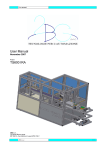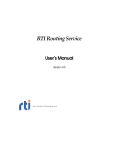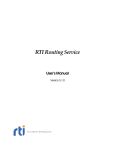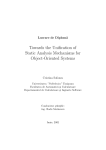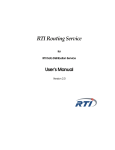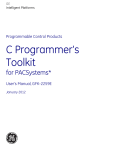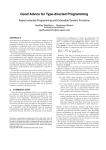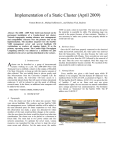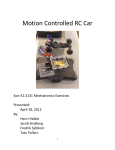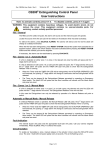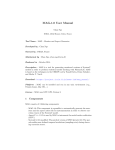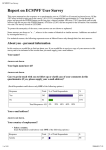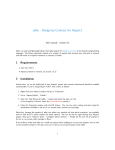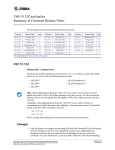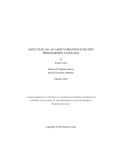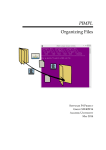Download DAJ User`s Guide V1.1
Transcript
DAJ User's Guide V1.1
by John J. Sung
Introduction
The integration between AspectJ and Demeter concepts came about as my Master's Thesis
topic. We wanted to gain a better understanding of how the concepts applied in AspectJ and
Demeter would interact. Importantly, we wanted to understand the fundamental concepts
applied and their interactions.
These concepts and their interactions are important in analyzing the tools based on these
concepts and in planning a directed development of these tools. In this analysis, we should be
able to determine the source of the expressive power of the tools, types of problems it solves
and potential complications.
Installation
Requirements
DAJ was developed with and compatible with java, aspectj and demeterj. The specific
versions used are listed below.
•
•
•
java sdk 1.3.1 or later from www.java.sun.com
aspectj 1.0 or later from www.aspectj.org
rt.jar of demeterj 0.8.4 or later from www.ccs.neu.edu/research/demeter/DemeterJava
Downloading and unpacking DAJ
Download the Latest version of DAJ from http://www.ccs.neu.edu/research/demeter/DAJ.
You should use your browser to download the jar file. Then, use the "jar xf daj[version].jar"
to unpack the DAJ in the desired location. It will create a directory structure that looks like
this:
daj[version]
daj.jar
basket
BasketMain.java
BasketMainCount.java
BasketTraversal.trv
basket2
BasketMain.java
BasketVisitor.java
BasketTraversal.trv
ccg
CreateClassGraph.java
Setting the Environment
You need to add these paths to your class path:
.
[fullpath]/daj.jar or if unpacked: [fullpath]/daj[version]
Here's an example classpath variable on windows:
.;d:\development\daj\daj1.0Alpha\daj.jar;d:\development\javacc\javacc1.1\JavaCC.zip;
d:\development\Demeter\demeterj-0.8.4\demeterj.jar;d:\development\Demeter\demeterj0.8.4\rt.jar;c:\jdk1.3\lib\dt.jar;c:\jdk1.3\lib\tools.jar;
d:\development\aspectj\aspectj1.0\lib\aspectjrt.jar;d:\development\aspectj\aspectj1.0\lib\aspec
tjtools.jar;
You also need to make sure that your environment is setup for java, aspectj, and demeterj's
runtime library. You do not actually need the demeterj.jar in your path to run DAJ, but I used
demeterj to implement DAJ. Thus, it is in my classpath.
If you are a frequent user of these tools, it might be a good idea to setup scripts to setup the
environment variables given a full path to these tools. This will facilitate upgrading of tools
and other software development activities. I have a tree of script calls that will setup the
environments that I tend to work frequently in and this strategy has allowed me to manage my
environment variables effectively.
Local CCS Installations
There is a local installation of DAJ available on CCS machines located at
/proj/demeter/jser/daj/latest. This is a symbolic link that is updated every time a new version
of DAJ is released. Setting up paths through this link ensures that latest version of DAJ is
used at all times.
Running DAJ
To run DAJ you need to pass DAJ as the class to execute the main method. DAJ requires 2
options, -ccg and -main. -ccg is the option to specify the location of the
CreateClassGraph.java file in the ccg directory. This file is compiles with the user code to
generate the implementation of the traversals specified within the trv files. The -main option
specifies the class that contains the main method for the user code. This class is passed to the
java vm in the traversal generation process.
The DAJ command line specification:
java edu.neu.ccs.demeter.daj.DAJ -ccg CreateClassGraph.java -main Main [options]
[java files] [trv files]
java files - files with .java extension that contains AspectJ code or pure java code.
trv files - files with .trv extension that contains the traversal specification. See Traversal
Files Format section for syntax and semantics of the traversal specification.
Required
-ccg [.java location] - Location of the CreateClassGraph.java file
-main [class name] - The class name of the class that contains the static main method
Optional
-gpa - This option generates printing advice for each of the traversals that outputs a trace
of the calls to the traversal methods.
-dtrv [directory path] - Outputs the generated traversal files to the specified directory.
-ajc "ajc compiler" - The string containing the actual command line for the ajc compiler.
This is used for using other than "ajc" for the compilation.
-ajtdebug - Printout the debug information for the traversal generation phase. This output
can be very large, however it does print out the actual traversal graph and the
code generated for each traversal. This can be useful in debugging your
strategy.
To run the Basket Example, you would type something like this:
java edu.neu.ccs.demeter.daj.DAJ -gpa -ajc "ajc.bat" -ccg
..\ccg\CreateClassGraph.java -main BasketMain -dtrv trav
BasketMain.java BasketMainCount.java BasketTraversal.trv
This line is also in basket.bat to be used on windows machines.
The Basket Example
Compiling and Running the Basket Example on Windows
This example run of the basket example is for windows. There is a basket.bat batch script file
that will run the example.
>basket.bat
Compiling Basket Example
%I - Generating Stubs
prefix for stub: trav
Generating Stub file: trav/BasketTraversal.java
%I - traversal generation compilation
ajc.bat d:\development\daj\dev\ccg\CreateClassGraph.java
BasketMain.java BasketMainCount.java trav/BasketTraversal.java
%I - traversal generation
java BasketMain -gpa -d trav BasketTraversal.trv
%I - traversal compilation
ajc.bat BasketMain.java BasketMainCount.java
trav/BasketTraversal.java
Running the Basket Example
call(void Basket.t1())
call(void Basket.t1_crossing_f())
call(void Fruit.t1())
call(void Fruit.t1_crossing_w())
call(void Weight.t1())
call(void Basket.t1_crossing_f2())
call(void Fruit.t1())
call(void Fruit.t1_crossing_w())
call(void Weight.t1())
Total weight of basket = 15
call(void Basket.t2())
call(void Basket.t2_crossing_f())
call(void Fruit.t2())
call(void Fruit.t2_copy1_crossing_w())
call(void Weight.t2_copy1())
call(void Basket.t2_crossing_f2())
call(void Fruit.t2())
Total weight2 of basket = 5
Compiling and Running the Basket Example on Unix
This example was ran on a Solaris machine, but it should work for other Unix machines.
> cd basket
> mkdir trav
> java edu.neu.ccs.demeter.daj.DAJ -gpa -ccg
../ccg/CreateClassGraph.java -main BasketMain -dtrv trav
BasketMain.java BasketMainCount.java BasketTraversal.trv
%I - Generating Stubs
prefix for stub: trav
Generating Stub file: trav/BasketTraversal.java
%I - traversal generation compilation
ajc ../ccg/CreateClassGraph.java BasketMain.java
BasketMainCount.java trav/BasketTraversal.java
%I - traversal generation
java BasketMain -gpa -d trav BasketTraversal.trv
%I - traversal compilation
ajc BasketMain.java BasketMainCount.java
trav/BasketTraversal.java
> java BasketMain
call(void Basket.t1())
call(void Basket.t1_crossing_f())
call(void Orange.t1())
call(void Fruit.t1_crossing_w())
call(void Weight.t1())
call(void Basket.t1_crossing_f2())
call(void Fruit.t1())
call(void Fruit.t1_crossing_w())
call(void Weight.t1())
Total weight of basket = 15
call(void Basket.t2())
call(void Basket.t2_crossing_f())
call(void Orange.t2())
call(void Fruit.t2_copy1_crossing_w())
call(void Weight.t2_copy1())
call(void Basket.t2_crossing_f2())
call(void Fruit.t2())
Total weight2 of basket = 5
The Explanation of the Basket Example
The Basket Example has been written to illustrate a typical use of DAJ. There are three files
to this example, BasketMain.java, BasketTraversal.trv, and BasketMainCount.java.
BasketMain.java - contains code for the class graph shown in Figure 1.
BasketTraversal.trv - contains the traversal specifications
BasketMainCount.java - contains an aspectj interpretation of a visitor that counts the weights
of the fruit within a Basket.
Basket
p
Pencil
f, f2
Fruit
Orange
w
Weight
c
Color
int i
s
String
Figure 1 : Class Graph (UML Diagram) of the Basket Example
The class definitions in BasketMain.java, shown below in File 1, defines the "schema" of the
data that we'll be working with. The actual instance is the object graph instantiated in the
main() method. The methods totalWeight1() and totalWeight2() are introduced within
BasketMain.Count.java. They start the traversals defined within BasketTraversal.trv and
count the numbers stored within the Weight class.
File 1: BasketMain.java
// The "Basket" example to illustrate an simple usage of
// DAJ.
// The class graph:
// has-a with a label: -label->
// is-a
: -<:// Basket -p->Pencil
//
-f->Fruit -w->Weight -i->int
//
\-<:- Orange -c->Color -s->String
//
class Basket {
Basket(Fruit _f, Pencil _p) { f = _f; p = _p; }
Basket(Fruit _f, Fruit _f2, Pencil _p) { f = _f; f2 = _f2;
p = _p; }
Fruit f, f2;
Pencil p;
}
class Fruit {
Fruit(Weight _w) { w = _w; }
Weight w;
}
class Orange extends Fruit {
Orange(Color _c) { super(null); c=_c;}
Orange(Color _c, Weight _w) { super(_w); c = _c;}
Color c;
}
class Pencil {}
class Color {
Color(String _s) { s = _s;}
String s;
}
class Weight{
Weight(int _i) { i = _i;}
int i;
int get_i() { return i; }
}
class BasketMain {
static public void main(String args[]) throws Exception {
Basket b = new Basket(new Orange(new Color("orange"),
new Weight(5)),
new Fruit( new Weight(10)),
new Pencil()
);
int totalWeight = b.totalWeight1();
System.out.println("Total weight of basket = " +
totalWeight);
totalWeight = b.totalWeight2();
System.out.println("Total weight2 of basket = " +
totalWeight);
}
}
The BasketTraversal.trv, File 2, contains the definitions for traversal methods t1() and t2().
The first class graph declaration declares a default class graph. This is the class graph defined
by the classes within the "current running program." This means that anything that you have
defined without packages will be in the class graph. The second class graph statement defines
a class graph slice, or a subgraph, using the strategy passed to it. The strategy defines a
traversal that does not pass through and edge with java.lang.String as the destination. It means
that the traversal will stop when it encounters java.lang.String class.
File 2: BasketTraversal.trv
// traversals for basket
aspect BasketTraversal {
ClassGraph default;
ClassGraph myClassGraph = new ClassGraph(default, "from
Basket to * bypassing {->*,*,java.lang.String }");
declare traversal t1(myClassGraph) : "from Basket to
Weight";
declare traversal t2(myClassGraph) : "from Basket via
Orange to Weight";
}
The third and fourth statements define traversals t1 and t2 using class graph slice that we have
defined. The traversal t1 defines a traversal that starts from Basket to all reachable Weight
objects, while traversal t2 defines a traversal that traverses to Weight only through the Orange
Object.
Basket
p
Pencil
f, f2
Fruit
Orange
w
c
Weight
Color
int i
s
String
Figure 2: Traversal Graph for t1 with strategy "from Basket to Weight"
The traversal graph for t1 is highlighted in Figure 2. As you can see, the traversal graph is a
subgraph of the original Class Graph. The traversal generation algorithm knows how to
handles the inheritance edges such that it behaves logically, i.e. if there's an Orange object, it
also treats it as a Fruit object.
Copy 0
Basket
f, f2
Copy 1
Fruit
Orange
Fruit
Orange
w
Weight
int i
Figure 3: Traversal Graph for t2 with strategy "from Basket via Orange to Weight"
For the traversal t2 with strategy, "from Basket via Orange to Weight" illustrated in Figure 3
is more complicated. It is because of the via statement. During the traversal, we must ensure
that we have traversed to an instance of Orange before getting to Weight. To do this, Demeter
creates two copies of the graph, copy 0 for the traversal that has not encountered an instance
of Orange and copy 1 that has encountered an instance of Orange.
When the traversal encounters a Fruit object, the traversal is stopped. When the traversal
encounters the Orange object, itself a Fruit object, it "jumps" to copy 1 and then continues the
traversal to Fruit then to Weight. This is how Demeter handles this case and DAJ generates
code that follows this algorithm.
In the BasketMainCount.java file, the methods totalWeight1() and totalWeight2() are
introduced to the BasketMain class. It's defines an aspect that is used to define the behavior
for counting the weights stored within a Basket object. The introduced methods initialize the
value to return to zero, call the traversal method and then returns the returnVal. The actual
work of addition occurs within the before advice. The pointcut for the before advice is used
for both t1 and t2 traversals.
File 3: BasketMainCount.java
// the aspect for counting the total weight of the basket
aspect BasketMainCount {
static int returnVal;
int Basket.totalWeight1() {
returnVal = 0;
t1();
return returnVal;
}
int Basket.totalWeight2() {
returnVal = 0;
t2();
return returnVal;
}
pointcut t2WeightPC(Weight weight) : (call(* *t2*()) ||
call(* *t1*())) && target(weight);
before(Weight weight) : t2WeightPC(weight) {
returnVal += weight.get_i();
}
}
In Demeter terminology, BasketMainCount.java is a visitor that traverses traversals t1 and t2.
The visitor counts the integers stored within the Weight objects that it encounters during the
traversal. Notice how the advice can be used for both traversal without modification. The
pointcuts would have to change if we only wanted it applicable for only one traversal instead
of two.
Traversal File Format
The traversal file format is designed such that it is syntactically similar to AspectJ. The idea is
that this extension to AspectJ could be integrated into the compiler in the future. Thus, it uses
aspect declaration, declare key words, etc. within it. In the traversal File, one can declare class
graph slices and traversals. DAJ takes these and generates AspectJ code that implements the
traversal.
The ClassGraph declaration can have two different forms, default or a class graph slice. The
default declaration is the ClassGraph object that is obtained from CreateClassGraph using DJ.
It has the form:
ClassGraph cg1;
ClassGraph defaultCG;
ClassGraph oneMoreDefaultCG1;
The Class Graph Slice form of the Class Graph declaration looks like a DJ Class Graph
constructor with a Class Graph and a strategy.
ClassGraph cg2 = new ClassGraph(cg1, "from A to B via C");
ClassGraph cg3 = new ClassGraph(cg2,
"from Me via Telephone to You");
Notice that the Class Graph Slice form of the Class Graph declaration needs to match the
previous declaration of the ClassGraph with the first argument of the ClassGraph constructor.
This is designed to make this look very much like DJ code.
The Traversal Declaration has two forms as well, a default traversal and a traversal with class
graph as an argument. The default traversal basically implements the traversal with the default
class graph and has the form:
declare traversal t1: "from A to B via C";
declare traversal myTraversal1: "from Me to You via EMail";
The traversal with class graph specification takes in a class graph and produces the traversal
with it. It has the form:
declare traversal t2(cg2): "from Here to There via Points";
declare traversal myTrav(default): "from A via X to B";
These traversal declarations generate AspectJ code that introduces methods Here.t2() and
A.myTrav(). Thus, the user may call these traversal methods in their code.
The last language feature is the aspect declaration. This is designed to look like AspectJ code.
If interested in AspectJ, check out www.aspectj.org. The aspect declaration should contain a
list of ClassGraph declarations and traversal declarations. Here is an example of an aspect
declaration.
aspect MyTraversal {
ClassGraph defaultCG;
ClassGraph cg1 = new ClassGraph(defaultCG,
“from * bypassing {java.lang.String} to *”);
declare traversal t1: “from CompoundFile to SimpleFile”;
declare traversal t2(cg1): “from CompoundFile to *”;
}
A .trv file should contain one and only aspect declaration and the name of the aspect should
match the file name before the .trv extension.
Warning! Strategies must have a valid class name for the start of the traversal specified
by the string after the keyword "from".
As of version 1.1, DAJ allows users to specify visitors for traversals. DAJ uses Java
Reflection to obtain the methods for a visitor and generate AspectJ advices for them. First the
user should specify some interface or class that specifies the different advice methods to be
called during a traversal.
Visitor methods that DAJ uses to generate code:
•
void start() – method called before the traversal starts
•
void finish() – method called after the traversal finishes
•
void before(C c) – method called before visiting a node of type C. The c
parameter is the object of type C it is currently visiting.
•
void after(C c) – method called after visiting a node of type C. The c
parameter is the object of type C it is currently visiting.
•
type around(C c) – method called instead of the traversal code
•
type returnValue() – method that returns the value it stores. Will be used in
later versions.
A visitor maybe declared using the syntax shown below in .trv files:
Visitor VisitorVariable;
Visitor v1;
After a visitor type has been specified, it maybe used to specify the visitor for specific
traversals using the traversal with class graph specification as shown below:
declare traversal t2(cg1,v1): “from CompoundFile to *”;
DAJ will generate AspectJ code that introduces two methods for this traversal specification
with a visitor. It will generate void t2() for the traversal and void t2(visitorType) for the
traversal with the visitor.
A complete example usage of visitors in a DAJ application is located in the directory basket2
of the DAJ installation directory.
Compilation Process
The compilation process that DAJ executes has four steps listed below.
•
Generation of Stubs based on the traversal
•
Compilation of CreateClassGraph.java, AspectJ files and Traversal Files
•
Execution of the compiled files with the class specified by the -main option. Traversal
implementation in AspectJ code is generated using DJ.
•
Compilation of AspectJ Files with generated traversal implementation.
During the generation of stub files, the traversal files with extension .trv is processed. A file
with the same name, but with .java extension is created and a method for the traversal is
introduced for the class that is the starting point for the traversal specified. This is needed for
the first compilation of the AspectJ code for traversal generation.
Introduction to Demeter Concepts
This sections is for developers that are not familiar with Demeter. We will introduce the basic
concepts behind Demeter and explain how Demeter tools DemeterJ and DJ apply these
concepts.
Demeter deals with the data and algorithm crossing cutting concerns. Because data and
algorithm are used everywhere, the scope in which these concepts maybe applied is very
large. The data is the Class Graph and the algorithm is further separated into Strategy and
Visitor. The way in which these are defined within DemeterJ, DJ, and DAJ differ but the
concept and the metaphor used are the same.
The Class Graph can be viewed as a schema that defines all possible Object Graphs, i.e. an
instance of the Class Graph. It has enough information to allow us to traverse the Object
Graph. Under the journey metaphor, Class Graph is in effect a map that we can follow to
carry out the Strategy.
The Strategy is nothing more than instructions on how to traverse a subgraph of the Class
Graph. Strategies like, "from Basket to Weight" and "from Company to Salary" are
instructions in how the traversal should be conducted. Minimally, a Strategy defines a start
node and an end node. However, more complex Strategies can include or exclude nodes or
specific edges. For example, the Strategy "from Basket via Orange to Weight" instructs the
visitor to traverse from Basket going through Orange to Weight. Thus, this strategy requires
the node Orange to be traversed before reaching Weight. Here's an example that excludes a
specific edge, "from Company to Salary bypassing ->Subsidiary,Europe,Division." It says to
traverse from Company to Salary but not going through the edge that connects Subsidiary and
Division together by label Europe. The nodes are Classes and the label is the name of the data
member in Demeter.
Now that we have defined the map that we can follow and the Strategy that we can follow to
find the right path in our journey, we need to define what happens during that journey. All we
have done so far is to define the route in which we'll be traversing. This is where Visitors
come into play. Visitors define advices on what to do before, after or around nodes during the
traversal. The bodies of these advices are like ordinary methods, except that it's passed the
node that it's currently visiting. Thus, you may do some operation on these nodes.
The operations defined by the advices are executed before we pass through the node, after we
have visited the node (on our return trip), or instead of (around) continuing the trip. You can
think of all before advices being executing during the trip going from the starting node to
destination node and the after advices being executed during the return trip from destination
to the starting node. This is a more general form of head recursive functions and tail recursive
functions. It's more general, because we can recurs through many different type of nodes
instead of just one type, i.e. the function itself. The around method is like a detour in the
journey, it allows some amount of control over the traversal during runtime. For example, it
might be desirable to stop the current traversal, continue the traversal or only traverse down a
subset of the paths available.
Class Graph
+
Traversal Graph
Strategy
+
Work Done
Visitor
Figure 4: DemeterJ Process
The DemeterJ Process in Figure 4 gives an overview of how the Class Graph, Strategy and
Visitor are used together to get work done. The Traversal Graph shown is a subgraph of the
Class Graph defined by applying the Strategy on that Class Graph. The interesting thing to
note is that the definition of these components is ambiguous. The set of nodes and edges
defined by the Class Graph, Strategy and Visitor can be disjoint, thus these components are
independent of each other. The Strategy might yield an empty Traversal Graph or the Visitor
defines advices for none of the nodes within the Traversal Graph, yielding no work.
References for DAJ Developers
DAJ - http://www.ccs.neu.edu/research/demeter/DAJ
• The DAJ User Manual
• The PowerPoint Presentation Tutorial
• Master's Thesis Proposal
DemeterJ - http://www.ccs.neu.edu/research/demeter
• DJ Fact Sheet & Resources
• DemeterJ Fact Sheet & Resources
• AP Library Fact Sheet & Resources
• "Adaptive Object-Oriented Software: The Demeter Method with Propagation
Patterns", Karl Lieberherr, PWS Publishing Company, Boston, 1996.
AspectJ - http://www.aspectj.org
• Documentation > index > AspectJ Tutorial
• Documentation > prog guide
• Documentation > dev guide
Java -http://www.java.sun.com
• Docs & Training > Java2 Standard Edition > J2SE 1.3 API English

















